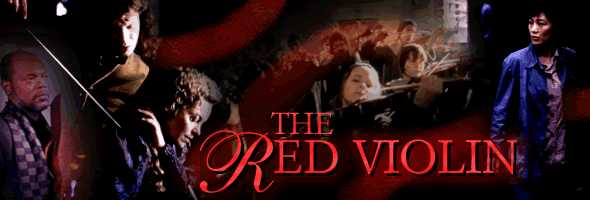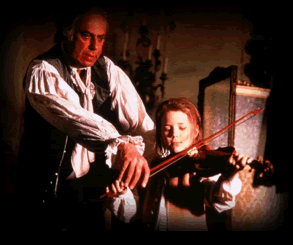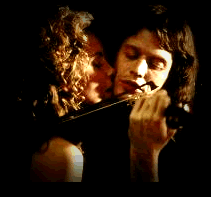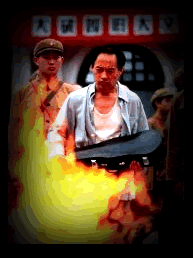
Color, 1999, 132 mins. Directed by François Girard
Starring Carlo Cecchi, Irene Grazioli, Jean-Luc Bideau, Greta Scacchi, Samuel L. Jackson, Jason Flemyng, Sylvia Chang, Colm Feore, Don McKellar / Produced by Niv Fichman / Music by John Corigliano / Cinematography by Alain Dostie
Format: DVD - Universal (MSRP $29.98)
Letterboxed (1.85:1) (16x9 enhanced) / Dolby Digital 5.1 / DTS
An intricate, elegantly mounted puzzle laced with macabre surprises, The Red Violin marks one of the few occasions in film history in which the central character is an object, not a living human being. Both entertaining and drenched in historical and artistic details, the film ambitiously traces the titular musical In Cremona, Italy during the late 1600s, a master craftsman, Nicolo Bussotti (Carlo Cecchi), prepares a violin as a gift for the unborn son of his beautiful expectant wife, Anna (Irene Grazioli). Their housekeeper provides a tarot reading for Anna which actually applies to the violin itself, foretelling a rich and dangerous life filled with trials and a wide array of people. Possibly cursed, the crimson violin passes into the hands of an orphaned music prodigy at an Austrian monastery. Renowned French composing legend Georges Poussin (Jean-Luc Bideau) brings the boy to Vienna; however, the ailing boy shows an unnatural, almost supernatural attachment to the instrument -- to such a degree that he even sleeps with the violin in his bed. The next owner, Frederick Pope (Jason Flemyng), is a passionate and perhaps Like a rich collection of short stories, The Red Violin succeeds by offering a wide palette of textures and characterizations which still manage to coalesce into a satisfying whole. Universal's DVD of The Red Violin made history as one of the first discs to incorporate both a Dolby Digital 5.1 and a DTS track, which makes it an ideal showcase for audiophiles. As would be expected, the soundtrack offers a nonstop barrage of panning effects, though the video looks impressive as well. Deliberately shot in a range of color schemes, the film no doubt proved to be a technical nightmare to transfer (and reportedly failed mightily on the Canadian DVD). However, the image quality on the Universal disc is consistently strong if not the kind of demo material found on some major studio titles. Interestingly, the title color only appears moderately throughout the film, with a much heavier emphasis on gray and blue occupying the visuals. Extras include the usual cursory production notes and bios, as well as the U.S. theatrical trailer.
 instrument across the globe and through the centuries in a bizarre, head-spinning chronicle of chance and human frailty.
instrument across the globe and through the centuries in a bizarre, head-spinning chronicle of chance and human frailty.
 demonic virtuoso who rises to fame and carries on a torrid affair with Victoria Byrd (Greta Scacchi), a beautiful novelist. However, she becomes resentful of the violin's presence, resorting to extreme behavior in a mixture of jealousy and revenge. In the 20th Century, the violin passes to Xiang Pei (Sylvia Chang), a Communist party official in Shanghai who cannot reconcile herself to the demands of her comrades to destroy all symbols of useless Western culture. Finally, in the present day (and the film's entire framing device), the Red Violin turns up in a prestigious Montreal auction where its authenticity is being determined by Charles Morritz (Samuel L. Jackson), a brusque man whose lifelong quest for Bussotti's last masterpiece uncovers a strange, disturbing secret.
demonic virtuoso who rises to fame and carries on a torrid affair with Victoria Byrd (Greta Scacchi), a beautiful novelist. However, she becomes resentful of the violin's presence, resorting to extreme behavior in a mixture of jealousy and revenge. In the 20th Century, the violin passes to Xiang Pei (Sylvia Chang), a Communist party official in Shanghai who cannot reconcile herself to the demands of her comrades to destroy all symbols of useless Western culture. Finally, in the present day (and the film's entire framing device), the Red Violin turns up in a prestigious Montreal auction where its authenticity is being determined by Charles Morritz (Samuel L. Jackson), a brusque man whose lifelong quest for Bussotti's last masterpiece uncovers a strange, disturbing secret.
 The auction structuring device allows the film to deftly slip between time periods without disrupting its dreamlike flow, pausing along the way for some wry commentary on modern society's materialistic fixations with status and possession (often overlooking true value in the process). Though a somewhat foregone conclusion, the tantalizing finale really poses more questions than it answers. As with the entire film, the ending suggests that morality and fate are entirely subjective, with people often projecting their destinies onto objects as a means of propelling themselves through life. Director Girard (32 Short Films about Glenn Gould) and writer/actor Don McKellar (Exotica, eXistenZ) admirably capture the atmosphere and period detail of each story along the way, with Jackson and Scacchi (who will apparently keep doing nude scenes for eternity) offering some of their best work to date. However, the Shanghai segment really steals the film thanks to some beautiful visual storytelling and Chang's expressive face, which speaks volumes where dialogue cannot. John Corigliano (Altered States) contributes his first film score in over fifteen years, and thankfully the wait was worth it; coupled with musician Joshua Bell's remarkable performances in each story, this Violin truly sings. Fans of less highbrow elements should also find plenty to enjoy, including the unexpected supernatural elements, fairly heated love scenes, and some startling, gruesome twists.
The auction structuring device allows the film to deftly slip between time periods without disrupting its dreamlike flow, pausing along the way for some wry commentary on modern society's materialistic fixations with status and possession (often overlooking true value in the process). Though a somewhat foregone conclusion, the tantalizing finale really poses more questions than it answers. As with the entire film, the ending suggests that morality and fate are entirely subjective, with people often projecting their destinies onto objects as a means of propelling themselves through life. Director Girard (32 Short Films about Glenn Gould) and writer/actor Don McKellar (Exotica, eXistenZ) admirably capture the atmosphere and period detail of each story along the way, with Jackson and Scacchi (who will apparently keep doing nude scenes for eternity) offering some of their best work to date. However, the Shanghai segment really steals the film thanks to some beautiful visual storytelling and Chang's expressive face, which speaks volumes where dialogue cannot. John Corigliano (Altered States) contributes his first film score in over fifteen years, and thankfully the wait was worth it; coupled with musician Joshua Bell's remarkable performances in each story, this Violin truly sings. Fans of less highbrow elements should also find plenty to enjoy, including the unexpected supernatural elements, fairly heated love scenes, and some startling, gruesome twists.
